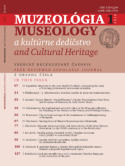The cultural heritage of the monasteries of Arkhangai aimag of Mongolia
The cultural heritage of the monasteries of Arkhangai aimag of Mongolia
Author(s): Olga TruevtsevaSubject(s): Museology & Heritage Studies, Geography, Regional studies, Modern Age, Recent History (1900 till today), Theology and Religion, Cultural Anthropology / Ethnology, History of Communism
Published by: Univerzita Komenského v Bratislave, Filozofická fakulta
Keywords: the cultural heritage of the monasteries; material culture; intangible cultural heritage; art; monuments; religious culture;
Summary/Abstract: The article is devoted to the problems of preservation of the monasteries of Arkhangai Aimag (one of the Provinces of Central Mongolia), which was from 1600-1920 a Center of Buddhist Art. There are many objects of cultural heritage – the tangible and intangible. Monasteries were founded in the XVIXVIII centuries at this region and played an important role in the economic and cultural development of Central Mongolia. Around monasteries formed a large settlement, city, trade, transport, craft and social infrastructure, developed education, medicine. A significant part of the residents of the Arkhangai Aimag devoted themselves to the service of the Monasteries. Monasteries were centers of culture and art. Silk road, crossing the Aimag, contributed to the integration, mutual influence of European and Asian cultures. From 1928 the Buddhist Religion was persecuted by the communist party. The Monasteries were collectivated. Already the adoption of the law on the separation of Church and State, the mass repressions of the second half of the 1930-ies most of the monasteries were destroyed, some changed to the use as utility rooms, ware-houses, institutions for culture. 1937 in relationship to Stalin’s Terror the Soviet Military was stationed in Mongolia and all of the Monasteries were closed or destroyed. Monks were taken from their positions in the Monasteries and secularized. Since 1990, Mongolia began the revival of religious associations, the return of former monasteries to liturgicactions. The surviving monastic building are the monuments of material culture. Many of them turned into ruins and relate to archaeological objects of cultural heritage. The article contains a general description of Buddhist Monasteries of Arkhangay Aimac, compiled in the course of the Russian-Mongolian expedition conducted in the summer of 2017 with the financial support of the Russian Foundation for Basic Research (RFFI) №17-21-03551. The article includes conclusions and recommendations for further study and use.
Journal: Muzeológia a kultúrne dedičstvo
- Issue Year: 6/2018
- Issue No: 1
- Page Range: 55-66
- Page Count: 12
- Language: English

